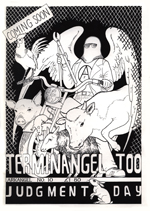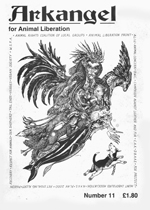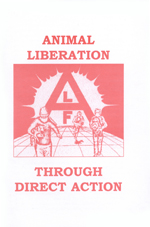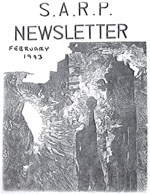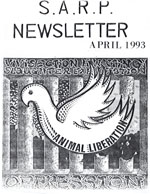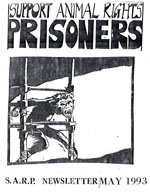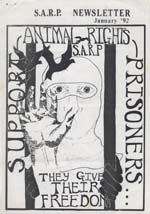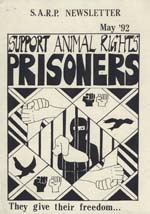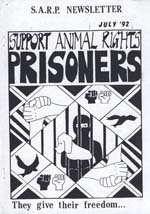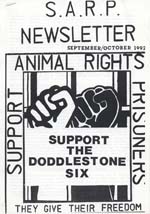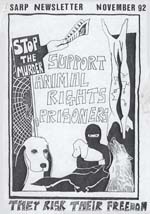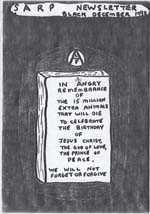The Archives
-
Site news & updates
Check out Leaflets of the Animal Rights Movement!
09.25.17 | PermalinkI know that the hiatus over here at TALON has gotten ridiculous- it’s a long story!- BUT in the meantime other folks have been carrying on with some spectacular projects. One that we really love is LARM, Leaflets of the Animal Rights Movement!
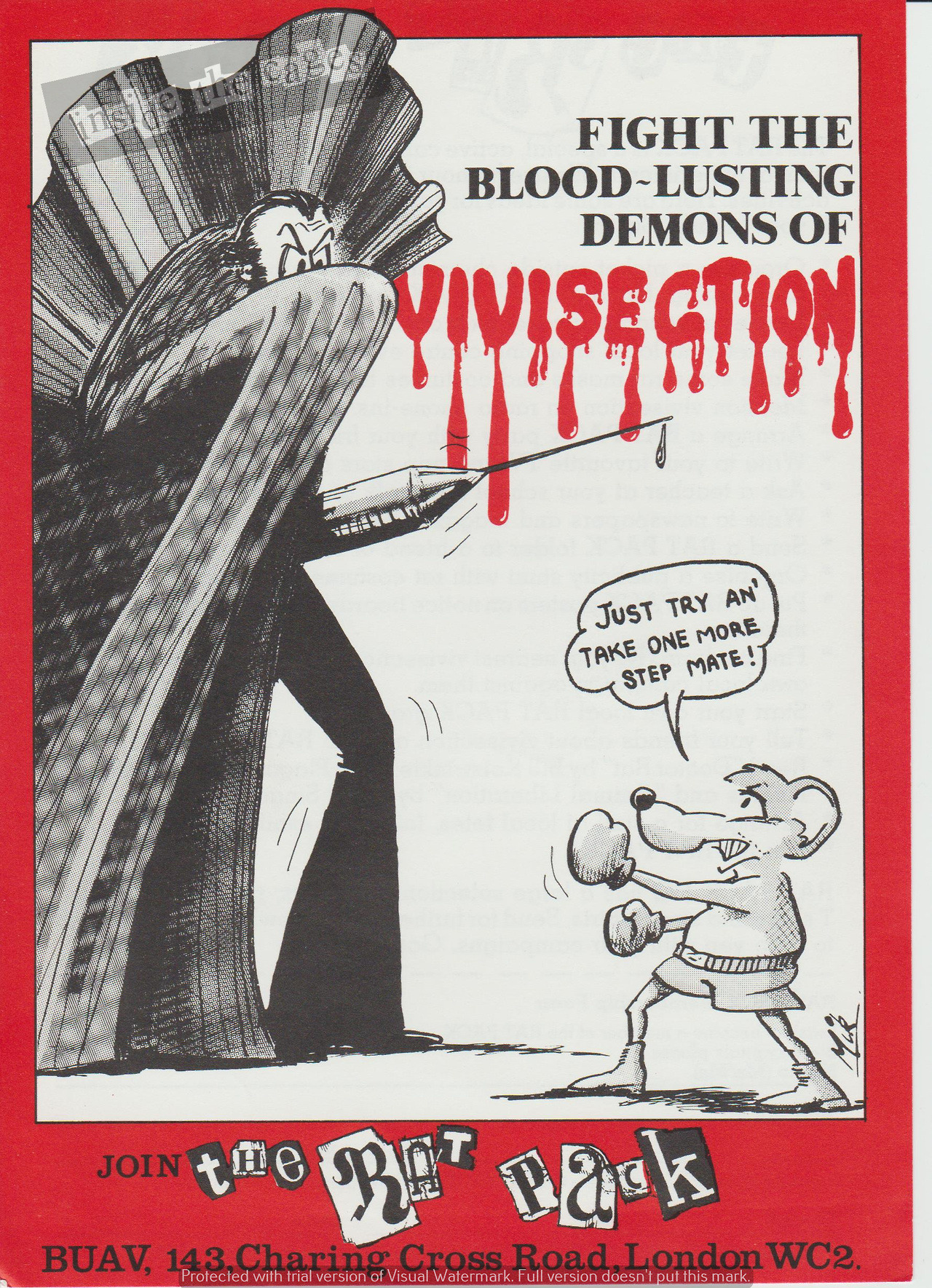
…
-
Arkangel, Periodicals
Arkangel #10-11
07.03.14 | PermalinkArkangel #10-11 (1993-1994. London, England.)
The early 1990s were a tumultuous time for the movement in England. Hunters began hiring professional security services to beat and harass saboteurs, the violence became so extreme that when Tom Worby was murdered by a hunt masters vehicle, the hunters nearby laughed and mocked his death. The hopefulness of the 1980s was fading away, and campaigners were becoming more hardened, which in turn led to a decline in public support as groups like the Justice Department began sending out small mail bombs. Many organizations were mired in infighting over strategy and issues of class and race. And then there was the problem of repression. Scotland Yard’s Animal Rights National Index had gathered detailed profiles on over 21,000 animal liberationists by 1990, and their spying on the movement was only set to intensify.
Through it all a dedicated core of individuals forged ahead and took animals from places of abuse, educated others about the plight of non-humans, and spread the message of compassionate action across oceans and artificial borders. Arkangel tells the story, and we are happy to continue our posting of the complete set here on TALON.
…
-
One-off publications
Animal Liberation Through Direct Action
03.28.14 | PermalinkAnimal Liberation Through Direct Action – (Date of publication unknown, likely 1998. Country of origin unknown, likely England)
Animal Liberation Through Direct Action was one of the better primers available in the 1990s. Designed for activists who had never before participated in illegal actions, the pamphlet discusses the basic security, surveillance, and planning necessary to carry out liberations and economic sabotage. It also includes a brief history of the movement, a first hand account of a mink farm raid, and statements from various ALF cells.
…
-
Periodicals
S.A.R.P. newsletters year 3
10.25.13 | PermalinkS.A.R.P. Newsletter #12-15 (1993 – Northampton, England)
Only a few short years after reforming Support Animal Rights Prisoners, the contributors to the project (primarily Barry Horne) threw in the towel. Their raison d’être was being fulfilled by the ALF SG newsletters, and Barry felt as if the group wasn’t having the unifying, inspirational impact that he had hoped for. The final issue, mostly written by press officer Robin Webb, starts off light and positive, but ends with an angry missive from Horne accusing most activists of being mere radical t-shirt collectors rather than actual radicals. Across the span of decades and beyond even his own death, this stab at those unwilling to fight for liberation still hits its mark. It is a sad ending to an information packed publication, but not every issue of this last year of SARP is so intense. Tiny fragments of our history fall off these pages like gold dust- collect them together and you have a treasure. Barry might have died on hunger strike, but he did not leave us behind. His words and actions will continue to remind us where we came from, and for whom we fight. Rest in peace, comrade, and thank you for all you have given us…
…
-
Campaign newsletters, Periodicals
Support Animal Rights Prisoners Newsletters: Year Two
07.30.13 | PermalinkS.A.R.P. Newsletter #6-11 (1992 – Northampton, England)
One of the big frustrations of working on the TALON site is that the materials we archive contain so much information it becomes difficult to organize and contextualize it all. Our posting of the Barry Horne SARP newsletter revival has made this sense of frustration more distinct than ever.
1992 was an eventful year for the movement: Mike Hill was murdered by hunter Alan Summersgill, the Doddlestone six were arrested protesting that murder, in North America Darren Thurston was arrested, Ronnie Lee was released, Kieth Mann was on remand and just about to escape from prison… This is just the tip of the iceberg as far as the significant events that took place over twelve long months twenty one years passed. We could spend pages discussing how these incidents shaped the future, how recent revelations about police informants in the UK have changed our understanding of old arrests, and so on. Unfortunately there is no time to pull at all of these strings- but the SARP newsletters certainly will provide inquisitive readers with many threads of their own to pull. From details of Operation Fox to “Laugh Along with the ALF,” each newsletter if filled with intriguing bits of our collective history.
…
-
Campaign newsletters, Periodicals
Support Animal Rights Prisoners newsletters: Year One.
06.17.13 | PermalinkS.A.R.P. Newsletter #1-5 (1991 – Northampton, England)
After a brief existence and quick demise in the 1980’s, the Support Animal Rights Prisoners organization was re-founded by Barry Horne and some friends in 1991. At the time Barry was imprisoned for possession of incendiary devices, but he never let incarceration keep him from participation in the movement. So, using a prison typewriter, he set to work writing the SARP newsletters. There are claims in the first issue that the material in SARP was written by a committee of five volunteers, but information we have received from reliable sources suggest that in actuality Barry wrote every issue of SARP except for the final issue, which was written by ALF Press Officer Robin Webb.
Barry was one of the most dedicated activists our struggle has ever known, but it would be a disservice to him to strip him of his humanity by pretending that he was without error. There are some poorly examined ideas in the pages of SARP that deserve measured critique, most especially that animal rights activists must, in all instances, preserve “unity.” Calls for unity are often used by those guilty of the most destabilizing behaviors as a way to avoid criticism for their own complicity in pushing people apart. During the era that SARP was being published there were concerted efforts by organized racists to join the movement, for car and postal bombings to be supported, and so on. Under such conditions total unity wouldn’t exactly be a good thing, right?
But for every weak idea presented in the pages of SARP, there are also beautiful moments that give voice to our imprisoned comrades, that remember our dead, and that call for nothing less than a revolution to liberate non-humans from the tyranny of the human species. Barry wrote with an intensity and single minded dedication that reminds us of just how precious each second spent fighting is, and how we must stop wasting those ticks of the clock. To Barry, life, and even death, should be utilized battling the scourge of speciesism. These newsletters are Barry’s voice ringing out from decades past, telling us to ACT NOW in solidarity with the animal nations.
…
-
No Compromise, Periodicals
No Compromise #23-26
02.17.13 | PermalinkNo Compromise 23-26 (2004, Santa Cruz / San Francisco, CA)
One of the lessons that archiving old animal liberation publications has taught me is that the most extreme actions have rarely produced much in the way of results for animals. A public that already sees veganism as odd might still see the value of rescuing animals from a laboratory, but will never support a car bombing. When innocents are injured, or when murder was the goal, the backlash starts to creep into our own ranks, and as we fracture law enforcement and industry groups take advantage. In the end, I can think of no bombing (or contamination, or grave robbing, etc.) which advanced the cause of animal rights more than it harmed it. This is not to say that bombings and the like could never be successful. At later stages of many revolutionary struggles, when the majority of the public supports the cause, bombs can clear away in one night what years of protest could not. While a movement is in its infancy, however, it could be argued that more often than not bombs blow up in our faces.
And so it was in 2004 when a group calling itself the Revolutionary Cells Animal Liberation Brigade carried out two bombings of HLS related targets in California. The movement was left to make lemonade from truly shitty lemons, and No Compromise did their best to mitigate the harm of the actions while keeping activists focused on the real enemy.
The year continued with the indictment of the SHAC 7, the emergence of Austria as a leader in the movement, and some exciting open rescues. Sarahjane Blum and Ryan Shapiro’s organization, GourmetCruelty.com, carried out one such operation that piqued public interest and eventually resulted in a sympathetic program on Animal Planet. Elsewhere Gina Lynn was imprisoned for defying the Seattle grand jury, Billy Cottrell was arrested for a massive SUV dealership arson, and the Universtiy of Iowa was treated to the most sophisticated lab raid to occur since the early 90s.
Every time we post a year of No Compromise we say the same thing: that this is essential reading for those who wish to understand the recent history of our movement. This posting is no exception. No Compromise was the best AR publication of its era, and 2004 saw the publication refining its strengths and providing their readers with four of the best issues yet.
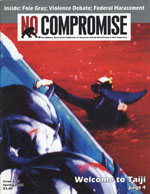



-
Periodicals
Liberate!
11.06.12 | PermalinkLiberate! #1-7 (1996-1997 Birkenhead, New Zealand)
Liberate! was published by Auckland Animal Action, one of the dozens of militant organizations that suddenly coalesced in the mid-90s. While the activities of the group itself were fairly moderate, the visual direction and rhetoric of the magazine was quite extreme. In it’s era this was appropriate. In these modern days of soy milk in every cafe and vegan cheese in every supermarket, talking about cutting off the fingers of vivisectors is certainly going to frighten away an audience that is already coming around. It wasn’t very long ago, however, that the late 80’s trend of moderation in activism was a clear failure. Dialogue about violence and sabotage was a necessary component of moving forward, and it is important to note that these discussions, thankfully, didn’t result in any missing digits.
Liberate! was not particularly well written, but there are some stand out articles about the burgeoning pro-direct action grassroots, conflicts between environmentalists and animal liberationists, and some entertaining imagery as well. Also of interest, given the current Canadian “Marineland Animal Defense” campaign, are the details of New Zealand’s 90s campaign against their own Marineland.
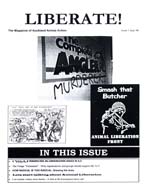
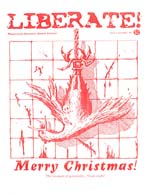
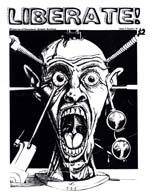
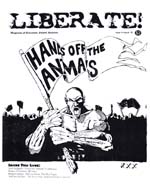
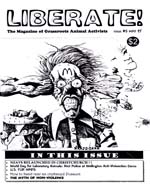
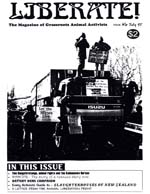
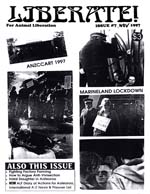
-
No Compromise, Periodicals
No Compromise #18-19
10.23.12 | PermalinkNo Compromise #18-19 (2001-2002. Santa Cruz, CA.)
If you have been following our posting of the complete No Compromise than you have read along as the new, 1990s militant grassroots took its first steps, stumbling along an exciting, and at times error filled path towards animal liberation. Those early years saw a lot of dedication and courage, but sadly little in the way of new tactics or intelligent planning.
That all changed in 2001 with the arrival of the anti-HLS campaign in the United States. The focus suddenly shifted from scattershot regional targeting to a single, international pressure point and the results were encouraging.
2001 wasn’t just about the fight against Huntingdon. The tactics developing in that one small struggle were inspiring activists globally to step up the fight against all areas of animal abuse, and sadly, some of our friends ended up in prison as a result. The support of these jailed comrades was inspiring, but our movement was dealt a terrible blow as Barry Horne died on Hungerstrike. That was not the only tragedy we would witness in these 12 months. Jeff Luers was sentenced to nearly 23 years in prison for an act of sabotage which harmed no one. Animal liberationists had been a strong force in the growing movement against globalization of capitalism, and at the 2001 G8 summit we watched as protestors and media were brutalized and bloodied in the lead up to the police murder of Carlo Giuliani. And of course, non-humans continued to be slaughtered in endless, unfathomable numbers. The tone of these two issues of No Compromise may have been optimistic, even cocky, but those of us on the ground knew that times were tough and getting tougher.
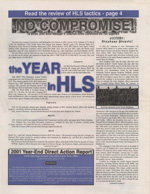

-
Periodicals
Facklan
10.11.12 | PermalinkFacklan (1996-1997 Umea, Sweden)
(Editors note: Facklan is a Swedish language publication that we bring to you due to its historical significance. Umea, Sweden produced one of the most remarkable animal liberation communities of the 1990s. Their influence was so strong that politicians in Sweden stated in national media that they feared animal rightists may collapse the countries infrastructure, both through sabotage and the conversion of the nations youth to veganism. Facklan was produced during the infancy of this tiny, but formidable uprising. One of our readers from Sweden has offered the summary that follows.)
Facklan (The Torch) was a Swedish magazine supporting the A.L.F. and
other radical groups fighting for the animals. It was released in four
issues in 1996-1997, during the biggest peak of A.L.F. activity in the
1990:ies in Sweden. The magazine was based in the northern city Umea,
which was well known for it’s number of vegans and animal rights
activists, militant (all fur shops closed in Umea as a result of the
A.L.F.) as well as non militant (almost 50 percent of the students at
some schools were vegetarians). Umea was often referred to as the
“Vegan Mecca”, and was also well known for bands promoting the animal
rights message, such as Refused.The first issue contained translated interviews etc from mainly UK and
US sources, and also had copied text from the Swedish militant
activist/anarchist manual Lila Svarta. Of course there was also a
diary of actions and addresses to imprisoned animal rights activists.
Two spreads were also dedicated to show mainstream media articles from
the time, also serving as a sign of the impact of the A.L.F. activity.During the later issues, more of the content was produced by Swedish
authors. In the second issue, there were a lot of more news from
Sweden and Finland, letters to the editor, communiques from the newly
started group The Wild Minks, a report from the riot against the fur
auction in Skara, a piece on the repression of Umea acitivists,
reviews of records under the headline “Activist Core”, and now also a
diary of actions focusing on Sweden. Content from abroad was still
used though, this time information from The Final Nail and on Barry
Horne. On the last page, a summary in English was also published for
the foreign readers.The third issue contained an exclusive interview with The Wild Minks,
the group that got most feared among the fur farmers, for liberating
minks and setting fire to properties of the fur industry. An address
list to all Swedish fur farms was published together with slogans such
as “What are you waiting for?”. There were critical articles directed
to hardcore posers, as well as articles about how animals that had
been liberated were doing in their new homes.The fourth and the last issue contained more articles like “How the
Raid was Done” – often raids that the police had said were so
professional it had to have been carried out by professionals from
abroad… One person urges for a Swedish A.L.F. Supporters Group, and
a spokesperson who could defend the actions openly. Til now, this had
only been done my anonymous activists in balaclavas, or by Emelie
E:son, an anonymous A.L.F. activist from the 1980:ies. Focus was also
targeted on groups trying to attack Peter Singer (who was at a visit
in Sweden during this period), there was a big report from the animal
rights campaigning and activity against the vivisection at the Umea
University, as well as more information directly from The Wild Minks.After the last issue, a Swedish A.L.F. Supporters Group was founded,
doing both work towards the media as towards prisoners and the animal
rights movement in general. They also released their own magazine,
later named Befriaren (The Liberator).



